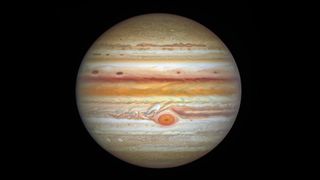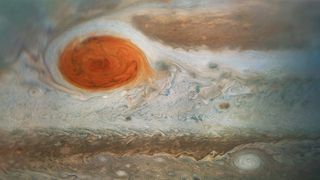Jupiter: Facts about the king of the planets
A round-up of information about Jupiter, the largest planet in the solar system.

Jupiter is the largest planet in the solar system and the fifth planet from the sun. The gas giant features beautiful banded cloud layers; a set of thin, dusty rings; the famous Great Red Spot; and dozens of varied moons.
How did Jupiter get its name?
As the fourth-brightest object in Earth's sky — after the sun, the moon and Venus — Jupiter has been known about since ancient times. Our modern name for the planet is derived from the Roman king of the gods, Jupiter.
For the ancient Greeks, Jupiter was known as Phaethon, which means "blazing star," while the Babylonians referred to the giant planet as Marduk, the patron deity of the city of Babylon. Other ancient names for Jupiter include Brhaspati (Sanskrit), Tzedek (Hebrew), Muxing (meaning "Star of Wood" in Mandarin) and Mushtari (Arabic), according to The Nine Planets.
What is Jupiter made of?
Jupiter is two and a half times more massive than all of the other planets in the solar system combined, and is chiefly composed of hydrogen and helium, according to the European Southern Observatory. The gas giant has a diameter of 88,846 miles (142,984 kilometers), making it 11 times wider than Earth, according to NASA.
Jupiter has no real surface, according to the agency; the planet is just a swirling mixture of gases flowing around in three distinct layers at its outermost edges. This region is thought to span approximately 44 miles (71 km), where the top layer is probably made of ammonia ice, the middle layer is likely made of ammonium hydrosulfide crystals and the innermost layer might be made of water ice and vapor.
The bright banded colors seen on Jupiter's outer surface are likely plumes of sulfur- and phosphorus-containing gases that rise up from the planet's warmer interior. Because the planet rotates extremely quickly, completing a single day in less than 10 hours, its outer atmosphere is separated into long belts of brighter and darker material, much like an extreme version of Earth's jet streams.
Storms in Jupiter's atmosphere can persist for many years and may extend 60 miles (100 km) into its interior. The renowned Great Red Spot is a single storm that has lasted at least 300 years, and data from NASA's Juno probe suggest that the storm goes down some 300 miles (480 km) into the planet's atmosphere — or about 40 times as deep as the Mariana Trench on Earth.

The Great Red Spot has been seen eating other, smaller storms, and scientists think that when certain cyclones slam into the spot, they increase its speed and, potentially, its lifetime. Near Jupiter's south pole, astronomers have found a dramatic hexagonal storm about the size of Texas surrounded by six other swirling maelstroms.
Data from Juno have shown that Jupiter's jet streams may reach depths of about 2,000 miles (roughly 3,200 km), according to NASA. Deeper in the atmosphere, increasing pressures and temperatures compress hydrogen gas into a liquid, meaning Jupiter has the largest ocean in the solar system, one made of hydrogen instead of water, according to NASA.
Somewhere around halfway to the gas giant's center, internal pressures become so great that electrons are squeezed off their parent hydrogen atoms, creating a superconductive metal that is thought to drive Jupiter's enormous magnetic field, according to the agency. The planet might have a central core of solid material or a thick, dense "soup," made mainly of iron and silicon, that could be up to about 90,000 degrees Fahrenheit (50,000 degrees Celsius).
How far is Jupiter from the sun?
Jupiter orbits at an average distance of 484 million miles (778 million km) from the sun, according to NASA. A year on Jupiter lasts 11.86 Earth years.
The planet has the shortest day in the solar system, lasting a breezy 9.93 hours. Its central axis is tilted only 3 degrees, unlike Earth's axial tilt of 23 degrees, meaning that Jupiter doesn't experience much seasonal variation throughout its year.
Have humans explored Jupiter?
One of the first people to make detailed observations of Jupiter was Italian astronomer Galileo Galilei, who gazed at the planet through his telescope in 1610, seeing its four largest moons, according to according to NASA. In modern times, humans have launched many probes that have flown past or orbited the gas giant.
The Pioneer 10 and 11 spacecraft, launched in March 1972 and April 1973, respectively, studied the asteroid belt and swept past Jupiter, gathering information about its intense radiation belts and snapping a few early photos, according to Live Science's sister site Space.com.
More impressive images had to wait until the Voyager 1 and 2 probes, both of which left Earth in 1977 and reached Jupiter in 1979, to take amazing observational data of the giant planet. The robots discovered Jupiter's faint and dusty ring system, the presence of volcanic activity on its moon Io and a few previously unknown moons.

NASA launched a dedicated Jupiter mission called Galileo, which arrived at and began orbiting the enormous planet in December 1995. Galileo studied Io and Jupiter's icy moon Europa in depth and released a probe that fell into Jupiter's atmosphere and took data on things such as temperature, wind speed and pressure on the planet.
The agency's latest dedicated Jupiter spacecraft is called Juno, which has been in orbit since July 2016. Juno passes over the planet's polar regions every 53.5 days and has studied its crazy powerful magnetosphere and bright auroras, among other things, ever since.
NASA is building a probe called Europa Clipper to study the icy moon and its subsurface ocean, which many scientists think could be a potential abode for life, according to NASA. In addition, the European Space Agency's Jupiter Icy Moons Explorer (JUICE) mission will explore Europa as well as two other large Jupiter moons: Ganymede and Callisto.
How many moons does Jupiter have?
There are currently 53 named moons of Jupiter, with a further 26 moons awaiting official names, according to according to NASA. Jupiter's largest moon, Ganymede, is the biggest moon in the solar system and is larger than Mercury.
The other Galilean satellites — named for their discoverer — are also gigantic worlds with their own interesting surprises. Callisto is one of the most heavily cratered objects in the solar system and may have a liquid ocean beneath its thick shell of ice. Europa has a similar ice and ocean structure, but its frozen outer shell is much thinner, meaning it is recycled more often and sports fewer craters. Brightly colored Io is the most volcanically active body in the solar system.
Could there be life on Jupiter?
Astronomer and science communicator Carl Sagan once speculated about the possibility of jellyfish-like organisms staying afloat using helium gas in Jupiter's atmosphere, but most researchers nowadays don't hold much hope for living organisms flitting about on the gas giant, according to Nature.
NASA considers Jupiter's moon Europa, which is covered in a shell of ice that surrounds an enormous body of liquid water, to be one of the likeliest places to find extraterrestrial life in the solar system. Europa may have giant ice spikes on its surface, though, making landing on the frozen world potentially difficult.

Additional resources
- You can fly around in a virtual version of the Jovian system with this interactive website from NASA.
- To explore images of Jupiter taken throughout the decades by different probes, check out this gallery from the National Air and Space Museum.
- You can also get the latest updates on the European Space Agency's JUICE mission or NASA's Europa Clipper spacecraft.
Bibliography
Cofield, C. (2016, June 28). Up close and personal with Jupiter: A history of 9 space probes. Space.com. https://www.space.com/33285-juno-history-of-jupiter-probes.html
European Southern Observatory. (n.d.). Jupiter. Retrieved April 21, 2022, from https://www.eso.org/public/usa/images/b03/
Margetta, R. (2021, October 29). NASA's Juno: Science results offer first 3D view of Jupiter atmosphere. NASA. https://www.nasa.gov/press-release/nasa-s-juno-science-results-offer-first-3d-view-of-jupiter-atmosphere
NASA. (2019, June 26). Europa: Exploration. https://solarsystem.nasa.gov/moons/jupiter-moons/europa/exploration/?page=0&per_page=5&order=launch_date+desc%2Ctitle+asc&search=&tags=Europa&category=33
NASA. (2019, June 26). Jupiter: Exploration. https://solarsystem.nasa.gov/planets/jupiter/exploration/?page=0&per_page=10&order=launch_date+desc%2Ctitle+asc&search=&tags=Jupiter&category=33
NASA. (2021, October 30). Jupiter: In depth. https://solarsystem.nasa.gov/planets/jupiter/in-depth/
NASA. (n.d.). Jupiter moons: Overview. Retrieved April 21, 2022, from https://solarsystem.nasa.gov/moons/jupiter-moons/overview/?page=0&per_page=40&order=name+asc&search=&placeholder=Enter+moon+name&condition_1=9%3Aparent_id&condition_2=moon%3Abody_type%3Ailike&condition_3=moon%3Abody_type
The Nine Planets. (n.d.). Planetary linguistics facts. Retrieved April 21, 2022, from https://nineplanets.org/planetary-linguistics.
Sign up for the Live Science daily newsletter now
Get the world’s most fascinating discoveries delivered straight to your inbox.

Adam Mann is a freelance journalist with over a decade of experience, specializing in astronomy and physics stories. He has a bachelor's degree in astrophysics from UC Berkeley. His work has appeared in the New Yorker, New York Times, National Geographic, Wall Street Journal, Wired, Nature, Science, and many other places. He lives in Oakland, California, where he enjoys riding his bike.
